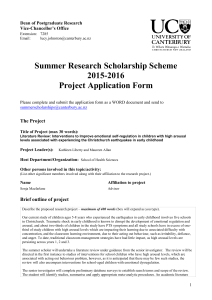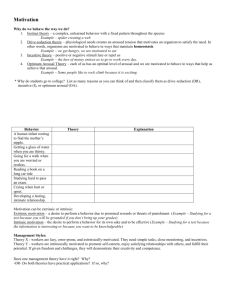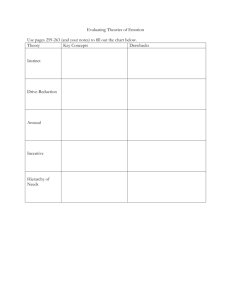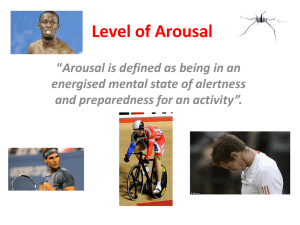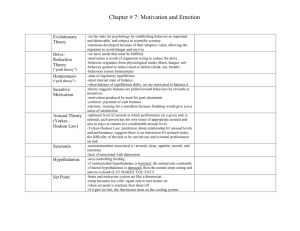The Influence of Arousal on Advertising Effectiveness
advertisement
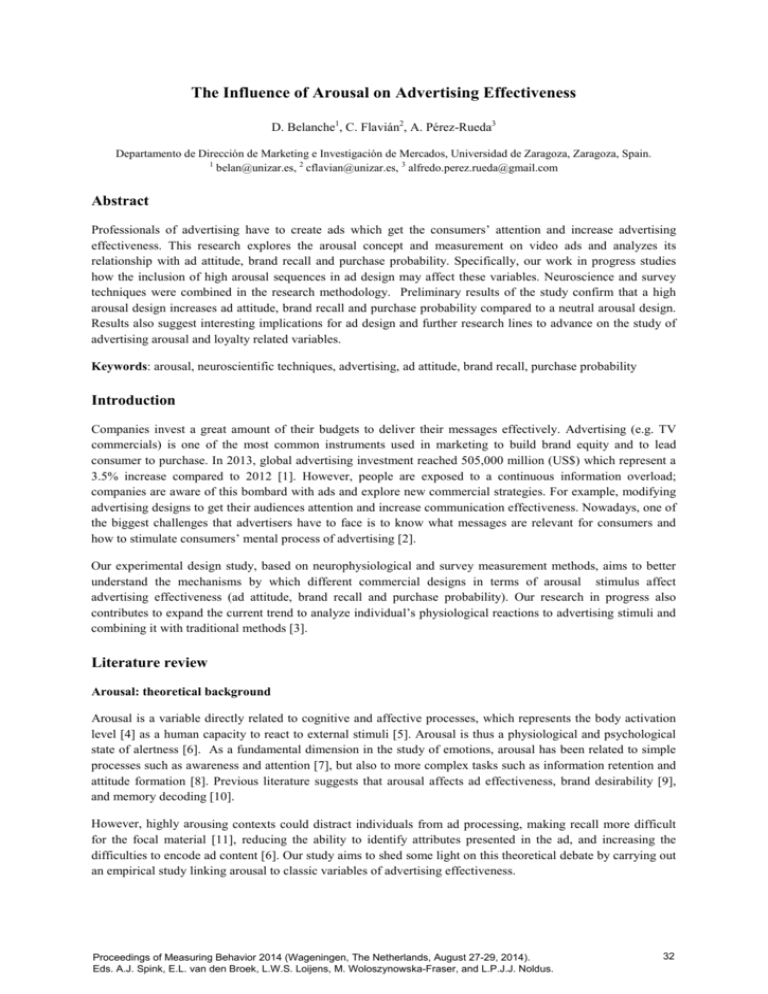
The Influence of Arousal on Advertising Effectiveness D. Belanche1, C. Flavián2, A. Pérez-Rueda3 Departamento de Dirección de Marketing e Investigación de Mercados, Universidad de Zaragoza, Zaragoza, Spain. 1 belan@unizar.es, 2 cflavian@unizar.es, 3 alfredo.perez.rueda@gmail.com Abstract Professionals of advertising have to create ads which get the consumers’ attention and increase advertising effectiveness. This research explores the arousal concept and measurement on video ads and analyzes its relationship with ad attitude, brand recall and purchase probability. Specifically, our work in progress studies how the inclusion of high arousal sequences in ad design may affect these variables. Neuroscience and survey techniques were combined in the research methodology. Preliminary results of the study confirm that a high arousal design increases ad attitude, brand recall and purchase probability compared to a neutral arousal design. Results also suggest interesting implications for ad design and further research lines to advance on the study of advertising arousal and loyalty related variables. Keywords: arousal, neuroscientific techniques, advertising, ad attitude, brand recall, purchase probability Introduction Companies invest a great amount of their budgets to deliver their messages effectively. Advertising (e.g. TV commercials) is one of the most common instruments used in marketing to build brand equity and to lead consumer to purchase. In 2013, global advertising investment reached 505,000 million (US$) which represent a 3.5% increase compared to 2012 [1]. However, people are exposed to a continuous information overload; companies are aware of this bombard with ads and explore new commercial strategies. For example, modifying advertising designs to get their audiences attention and increase communication effectiveness. Nowadays, one of the biggest challenges that advertisers have to face is to know what messages are relevant for consumers and how to stimulate consumers’ mental process of advertising [2]. Our experimental design study, based on neurophysiological and survey measurement methods, aims to better understand the mechanisms by which different commercial designs in terms of arousal stimulus affect advertising effectiveness (ad attitude, brand recall and purchase probability). Our research in progress also contributes to expand the current trend to analyze individual’s physiological reactions to advertising stimuli and combining it with traditional methods [3]. Literature review Arousal: theoretical background Arousal is a variable directly related to cognitive and affective processes, which represents the body activation level [4] as a human capacity to react to external stimuli [5]. Arousal is thus a physiological and psychological state of alertness [6]. As a fundamental dimension in the study of emotions, arousal has been related to simple processes such as awareness and attention [7], but also to more complex tasks such as information retention and attitude formation [8]. Previous literature suggests that arousal affects ad effectiveness, brand desirability [9], and memory decoding [10]. However, highly arousing contexts could distract individuals from ad processing, making recall more difficult for the focal material [11], reducing the ability to identify attributes presented in the ad, and increasing the difficulties to encode ad content [6]. Our study aims to shed some light on this theoretical debate by carrying out an empirical study linking arousal to classic variables of advertising effectiveness. Proceedings of Measuring Behavior 2014 (Wageningen, The Netherlands, August 27-29, 2014). Eds. A.J. Spink, E.L. van den Broek, L.W.S. Loijens, M. Woloszynowska-Fraser, and L.P.J.J. Noldus. 32 Measurement of arousal Arousal is difficult to analyze and it has been commonly measured by self-report techniques. In contrast, some authors claim for a more accurate measurement using also physiological responses [12]. Combining different neuroscience techniques is advantageous for most marketing research fields, such as the emotional reaction measurement to advertising [3]. Functional magnetic resonance (fMRI) [13], electroencelography (EEG) [14], Electromiogram (EMG) [15], and skin conductivity [16] are surely the most relevant of neurophysiological techniques applied nowadays to better understand consumer behavior. Hypotheses formulation Memory, affect, and persuasion are the three basic cognitive motivation fundaments in consumer information processing [17]. Getting the viewers’ attention is one of the first steps to process ad information and arousal stimulus helps to get it [10] as an impulse demanding cognitive operations [18]. Ad attitude (AAd) is probably one of the most analyzed construct in marketing research [19]. AAd is defined as ‘‘a learned predisposition to respond in a consistently favorable or unfavorable manner to advertising in general’’ [20, p. 53] and has cognitive and affective foundations [21]. AAd is a useful predictor of behavioral intentions, for this reason, a critical variable for advertising designers [22]. A cue stimulating emotional response may result in a favorable AAd, increasing the involvement and attention to the ad [21]. When consumers observe a specific exciting video sequence, they react unconsciously (high-arousal) by activating attention to achieve a more accurate memorization [10]. The stimulus acquires significance through an association process to remember other ad elements (e.g. the brand name). Accordingly, we propose that brand recall is higher for ads with a high arousal design compared with ads without them. Additionally, often, the ultimate ad goal is to cause the greatest impact on future purchase behavior after ad exposure. Since high arousal stimuli involve consumers’ reactions such as changes or emotional states activation [23], this positive stimulation may play an important role in the purchase probability too. All in all, the research hypotheses are: Hypotheses 1-3: Compared to a neutral arousal video design, a high arousal video design has a positive influence on ad attitude (H1), brand recall (H2), and purchase probability (H3). Method Pretest: arousal measurement and ad selection A pretest with a sample of 42 individuals was carried out with the aim of selecting the video ads that will be used in the experiment. The instrumentation used (electroencephalograph, skin conductance sensor and other biosensors) and the video presentation was synchronized within the common amplifier and the software. The participants were asked to sit comfortably and watch 24 videos of different nature. The videos were presented randomly within 3 blocks of 8 videos, with an inter-video time of 10 seconds and inter-block time of 3 minutes. This method provided an aggregated arousal measurement for each video, obtained by the arousal superposition of each subject. The video with a more variation in arousal in terms of aggregated activations was selected. The data were collected and analyzed by the company BitBrain Technologies®, and then given for the present study. Proceedings of Measuring Behavior 2014 (Wageningen, The Netherlands, August 27-29, 2014). Eds. A.J. Spink, E.L. van den Broek, L.W.S. Loijens, M. Woloszynowska-Fraser, and L.P.J.J. Noldus. 33 Experimental Design Participants of the study were 73 graduate and postgraduate students of a Spanish University who were invited to participate in a marketing research and randomly assigned to each of the two conditions: with high arousal peak design (N=37), neutral design (N=36). Taking as a basis the pretest video, the two experimental video scenarios of 30 seconds were created. The first manipulated condition presented a video with a high arousal peak and 8 seconds later the brand name (“Adventure cam”) during 3 seconds. The second scenario did not have any high arousal peak (neutral condition) and presented the same invented brand name at the same second than the first scenario. In all the cases, the manipulated spot was inserted in a sequence between two neutral ads (in terms of arousal) of 45 seconds each. Measurement AAd was measured by three items using 7-point Likert scales. Specifically, respondents had to indicate their level of agreement with the following statements: “I like the advert”, “The ad get my attention” and “The ad is interesting to me” (Cronbach α =.84). Brand recall was measured by a direct question asking the name of the announced brand and coded by two external judges. Purchase probability was measured by a 7-point scale (from very low to very high probability). Results Participants responses analysis confirmed our hypotheses 1 and 3. In support of H1, participants in the high arousal condition presented significant higher levels of AAd on average (M=5.44; s.d.=.98) than those in the neutral condition (M=4.69; s.d.=1.30), t (70)=2.79, p=.001). On the other hand, results reject H2. Brand recall is higher for participants in the high arousal condition compared to the neutral condition, but this difference is not significant. Finally, in support of hypothesis 3, also the difference of purchase probability is significantly higher in the high arousal condition (M=3.08; s.d.=1.30) than in the neutral ad design condition (M=2.08; s.d.=1.16), t (70)=. 3.46, p=.01). Conclusions and discussion Our work in progress proposes that different high/neutral video advertising designs affects advertising effectiveness. Results lead us to the following conclusions: First, AAd is higher in a high arousal design condition. This result suggests that consumers prefer, enjoy and get involve with high arousal advertising compared to a non-stimulating ad. Second, brand recall is marginally higher for video ads presenting a high arousal design. To certain extent, a high arousal stimulus helps get viewers’ attention and memorize brand name. Thus, a neutral arousal design may involve attention activation lack and memory processes. This finding agrees with those in previous studies linking arousal, attention, and recall [9]. Finally, the study results reveal a significant difference in purchase probability between the video ads presenting high arousal design versus neutral design. Thus, this finding suggests that the high arousal design captures not only the viewers’ interest but also increases consumer attraction toward the product as indicated by a higher purchase probability. In sum, people are exposed to a continuous information overload; so much information generates consumer indifference. Our research supports that a high arousal sequence in video advertising helps to wake up the conscious and subconscious mind, getting the spectator attention and facilitating message processing. Proceedings of Measuring Behavior 2014 (Wageningen, The Netherlands, August 27-29, 2014). Eds. A.J. Spink, E.L. van den Broek, L.W.S. Loijens, M. Woloszynowska-Fraser, and L.P.J.J. Noldus. 34 Implications and further research lines These preliminary findings of our research suggest management implications specifically remarkable for advertising design. Initially, our studies supports that a high arousal scene increase advertising effectiveness. Our conclusions that a higher AAd, and purchase probability are achieved with a high arousal stimulus design suggest that advertisers should include a high arousal stimulus in their ad design for a more effective communication. This finding relies on the argument that a high arousal stimulus favors a consumer positive experience and increase viewers’ attention, and therefore, activates their information processing for a better brand memorization and product likeability. Our work in progress also presents several limitations that advocate for further analyses, and interesting research lines. In this sense, one of our research limitations is that our research does not directly measure attention. Although measuring attention is not an easy task [12], a future research line could be devoted to clarify the attention role on studies linking arousal to advertising effectiveness. Similarly, our research describes and operationalizes arousal as a general psychophysiological activation not directly related to any specific emotion. Further research lines should specifically test our proposed relationship under different emotions, and study a potential variation of arousal effects on advertising effectiveness depending on emotional states such as positive or negative valenced emotions. Our research studies could be complemented by additional measurements, different scenario designs, and logo placements [24]. References [1] Zenith Optimedia. (2013, December 5). Advertising Expenditure Forecasts September 2013. In http://www.zenithoptimedia.com/wp-content/uploads/2013/09/Adspend-forecasts-September-2013executive-summary.pdf [2] Ohme, R., Reykowska, D., Wiener, D., Choromanska, A. (2009). Analysis of neurophysiological reactions to advertising stimuli by means of EEG and galvanic skin response measures. Journal of Neuroscience, Psychology, and Economics, 2(1), 21. [3] Ariely, D., & Berns, G. S. (2010). Neuromarketing: the hope and hype of neuroimaging in business. Nature Reviews Neuroscience, 11(4), 284-292. [4] Gould, D., Krane, V. (1992). The arousal-athletic performance relationship: Current status and future directions. In T. Horn (Eds), Advances in Sport Psychology (pp.119-142). Champaing IL: Human Kinetics. [5] Benedek, M., Kaernbach, C. (2010). Decomposition of skin conductance data by means of nonnegative deconvolution. Psychophysiology, 47(4), 647-658. [6] Shapiro, S., MacInnis, D. J. (2002). Understanding program-induced mood effects: Decoupling arousal from valence. Journal of Advertising, 31(4), 15-26. [7] Boucsein, W. (1992). Electrodermal activity. (2º ed.). New York: Plenum University Press. [8] Holbrook, M. B., Hirschman, E. C. (1982). The experiential aspects of consumption: consumer fantasies, feelings, and fun. Journal of consumer research, 9(2), 132-140. [9] Aaker, D. A., Stayman, D. M., Hagerty, M. R. (1986). Warmth in advertising: Measurement, impact, and sequence effects. Journal of Consumer Research, 12(4), 365-381. [10] Jeong, E. J., Biocca, F. A. (2012). Are there optimal levels of arousal to memory? Effects of arousal, centrality, and familiarity on brand memory in video games. Computers in human behavior, 28(2), 285291. [11] Singh, S. N., Hitchon, J. C. (1989). The intensifying effects of exciting television programs on the reception of subsequent commercials. Psychology & Marketing, 6(1), 1-31. [12] Öhman, A., Birbaumer, N. (1993). Psychophysiological and cognitive-clinical perspectives on emotion: Introduction and overview. In N. Birbaumer & A. Öhman (Eds.), The organization of emotion: cognitive, clinical and psychophysiological perspectives.Göttingen: Hogrefe. Proceedings of Measuring Behavior 2014 (Wageningen, The Netherlands, August 27-29, 2014). Eds. A.J. Spink, E.L. van den Broek, L.W.S. Loijens, M. Woloszynowska-Fraser, and L.P.J.J. Noldus. 35 [13] Plassmann, H., Kenning, P., Deppe, M., Kugel, H., Schwindt, W. (2008).How choice ambiguity modulates activity in brain areas representing brand preference: Evidence from consumer neuroscience. Journal of Consumer Behaviour, 7(4–5), 360–367. [14] Bertin, M., Tokumi, R., Yasumatsu, K., Kobayashi, M., Inoue, A. (2014). Application of EEG to TV Commercial Evaluation. In Biomedical Informatics and Technology, 277-282. [15] Hazlett, R. L., Hazlett, S. Y. (1999). Emotional response to television commercials: Facial EMG vs. self-report. Journal of Advertising Research, 39(1), 7-24. [16] Sundar, S. S., Kalyanaraman, S. (2004). Arousal, memory, and impression-formation effects of animation speed in web advertising. Journal of Advertising, 33(1), 7-17. [17] Johar, G. V., Maheswaran, D., Peracchio, L. A. (2006). Mapping the frontiers: Theoretical advances in consumer research on memory, affect, and persuasion. Journal of Consumer Research, 33(1), 139-149. [18] Ohme, R., Matukin, M., Szczurko, T. (2010). Neurophysiology uncovers secrets of TV commercials. der markt, 49(3-4), 133-142. [19] Bergkvist, L., Rossiter, J. R. (2007). The predictive validity of multiple-item versus single-item measures of the same constructs. Journal of Marketing Research, 44(2), 175-184. [20] Lutz, R. J. (1985). Affective and cognitive antecedents of ad attitude: A conceptual framework. In Psychological processes and advertising effects theory, research, and application (pp. 45–63). Hillsdale, NJ: Lawrence Erlbaum Associates. [21] Shimp, T. A. (1981). Attitude toward the ad as a mediator of consumer brand choice. Journal of Advertising, 10(2), 9-48. [22] Mitchell, A. A., Olson, J. C. (1981). Are product attribute beliefs the only mediator of advertising effects on brand attitude? Journal of Marketing Research, 18, 318-332. [23] Cheng, F. F., Wu, C. S., Yen, D. C. (2009). The effect of online store atmosphere on consumer’s emotional responses–an experimental study of music and colour. Behaviour & Information Technology, 28(4), 323-334. [24] Pieters, R., Warlop, L. (1999). Visual attention during brand choice: The impact of time pressure and task motivation. International Journal of Research in Marketing, 16(1), 1-16. Proceedings of Measuring Behavior 2014 (Wageningen, The Netherlands, August 27-29, 2014). Eds. A.J. Spink, E.L. van den Broek, L.W.S. Loijens, M. Woloszynowska-Fraser, and L.P.J.J. Noldus. 36


